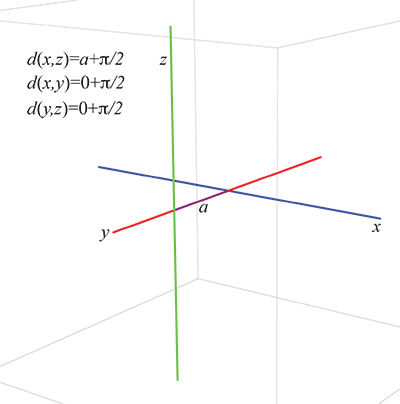I seek a metric $d(\cdot,\cdot)$ between pairs of (infinite) lines in $\mathbb{R}^3$. Let $s$ be the minimum distance between a pair of lines $L_1$ and $L_2$. Ideally, I would like these properties:
If $L_1$ and $L_2$ are parallel, then $d(L_1,L_2) = s$.
$d(L_1,L_2)$ increases with the degree of skewness between the lines, i.e., the angle $\theta$ between their projections onto a plane orthogonal to a segment that realize $s$, where $\theta=0$ for parallel lines and $\theta=\pi/2$ for orthogonal lines.
A natural definition (suggested in an earlier MSE question) is $d(L_1,L_2) = s + |\theta|$.
But this is not a metric.
For example, a sufficiently large value of $a$ below ensures the triangle inequality will be violated:

I would be interested to learn of metrics defined on lines in space, and whether or not any such metric satisfies the properties above.
Perhaps the properties cannot be achieved by any metric?
Update. Here is my current understanding of the rich variety of the erudite answers provided. Apologies in advance if my summary is inaccurate.
First, there is no such metric, interpreting my second condition as (naturally) demanding invariance under Euclidean motions, as convincingly demonstrated by Robert Bryant, Vidit Nanda, and Pierre Simon.
Second, a looser interpretation requires only that if we fix $L_1$, then $d(L_1,L_2)$ is monotonic with respect to $\theta$ as $L_2$ is spun "about their intersection point in the plane that contains them [Yoav Kallus]." Then, Will Sawin's metric satisfies this condition. Here is an example of why this metric fails the more stringent condition—it depends on the relationship between the lines and the origin:

The right lines could be further apart than the left lines (depending on $a$ and $b$).

